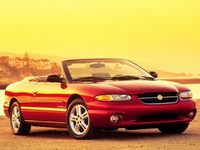New Car Review
SEE ALSO: Chrysler Buyer's Guide
1996 Chrysler Sebring Convertible JXi
by John Heilig
SPECIFICATIONS
ENGINE: 2.5-liter SOHC 24-valve V-6
HORSEPOWER/TORQUE 168hp@5800 rpm/1701b.-ft.@4350 rpm
TRANSMISSION: Four-speed automatic
FUEL ECONOMY: 20 mpg city, 29 mpg highway 26.0 mpg test
WHEELBASE: 106.0 in.
OVERALL LENGTH: 193.0 in.
OVERALL HEIGHT: 54.8 in.
OVERALL WIDTH: 69.2 in.
CURB WEIGHT: 3432 lbs
FUEL CAPACITY: 16.0 gal.
LUGGAGE CAPACITY: 11.3 cu. ft.
TIRES: P215/55R16
INSTRUMENTS: Speedometer, tachometer, fuel level, water temperature,
digital clock.
EQUIPMENT: Power windows, power door locks, power mirrors, power top,
cruise control, air conditioner, AM-FM stereo radio with cassette and CD,
anti-lock braking, dual air bags.
STICKER PRICE: $25,210
There's a lot of good things to be said about the Chrysler Sebring convertible. there are some bad things to be said, too. But all in all, the vehicle accomplishes its purpose very well and does what it set out to do.
Not many people are aware that Chrysler has been one of the top selling (if not the top selling) convertibles in the United States for several years. The car that has fueled those sales was the LeBaron, a K-Car that was so old in design that one might think it arrived with the dinosaurs--but it didn't.
LeBaron was an old design that was the last vestige of the Iacocca era. The Sebring on the other hand is a brand new design. And while it's based on the Sebring coupe, it is a totally different car. The convertible uses the JA platform that is shared with the Cirrus and Stratus, while the coupe uses the FJ platform. What makes this combination unique is that the Sebring is a two-door "small car," while the Cirrus and Stratus are four-door "large" cars. The convertible is built in Toluca, Mexico.
The bane of-all convertibles is-chassis flexing. Take a convertible on a rough road or one that has a lot of undulations -in it and you can feel the chassis flexing. As the wheels go up in opposition to the one on the other side of the axle, you can actually feel the chassis flex. You don't get this feeling in the Sebring convertible. It has a stability that many other ragtops its size don't have. Which makes driving it more pleasant.
Sebring is a four-seater by design and actuality. We put four passengers in the Sebring on several occasions on one long trip with no complaints. Granted, we didn't have the front seats pushed all the way back on the stops, but we did have comfortable legroom up there.
However, as with all convertibles, trunk space is extremely limited. That top has to go somewhere. The Sebring convertible's trunk is rated at 11 cubic feet, and if you want to carry the tonneau that covers the top when it's down, then trunk space is limited even more. We did have enough luggage space for two of us on along trip, but I wouldn't take the Sebring Convertible on a long trip unless you do some creative packing with soft-sided duffel-type bags.
Front seats were comfortable. They offered decent side support, although I would have liked more. But since this isn't a great handling car, the side support was adequate. The Sebring convertible's independent front and rear suspension is comprised of unequal length upper and lower control arms, but even with a thick stabilizer bar, handling is designed more for comfort than performance.
What kind of driving did we give this car. We put a lot of Interstate miles on it. We drove on the Blue Ridge Parkway and Skyline Drive in Shenandoah National Park. And we drove on the normal daily commute. So we put a variety of miles on the car and were pleased with what it gave back. One other satisfying feature is the admiring glances you get from other drivers.
The top operation is very simple. You unlatch two hooks at the A-pillar and a motor does the rest. We also liked the heating/air conditioning system. At the time of year we drove the Sebring we had an opportunity to use both. There was some wind noise around the window seals and more wind noise around the top.
But the most noise came from what I felt was the Sebring's major detraction, and that was the engine. Sebring is powered by a 2.5-liter V-6 that is rated at 168 horsepower. This is an adequate figure that can get the Sebring up to its comfortable operating speed of 70-75 mph, where it can cruise all day economically and with little fuss. But it makes a lot of noise getting there, and if you want to accelerate, it's like stepping on a cat's tail. You get a lot of noise and commotion, but not much good comes out of it all.
But except for this minor engine problem-and I hope Chrysler gets smart and puts a quieter engine in the next generation--the Sebring Convertible is a nice vehicle. It's sharp looking and attracts admiring glances. It's a fun car to drive. It's not a great car, but it's a fun car.



